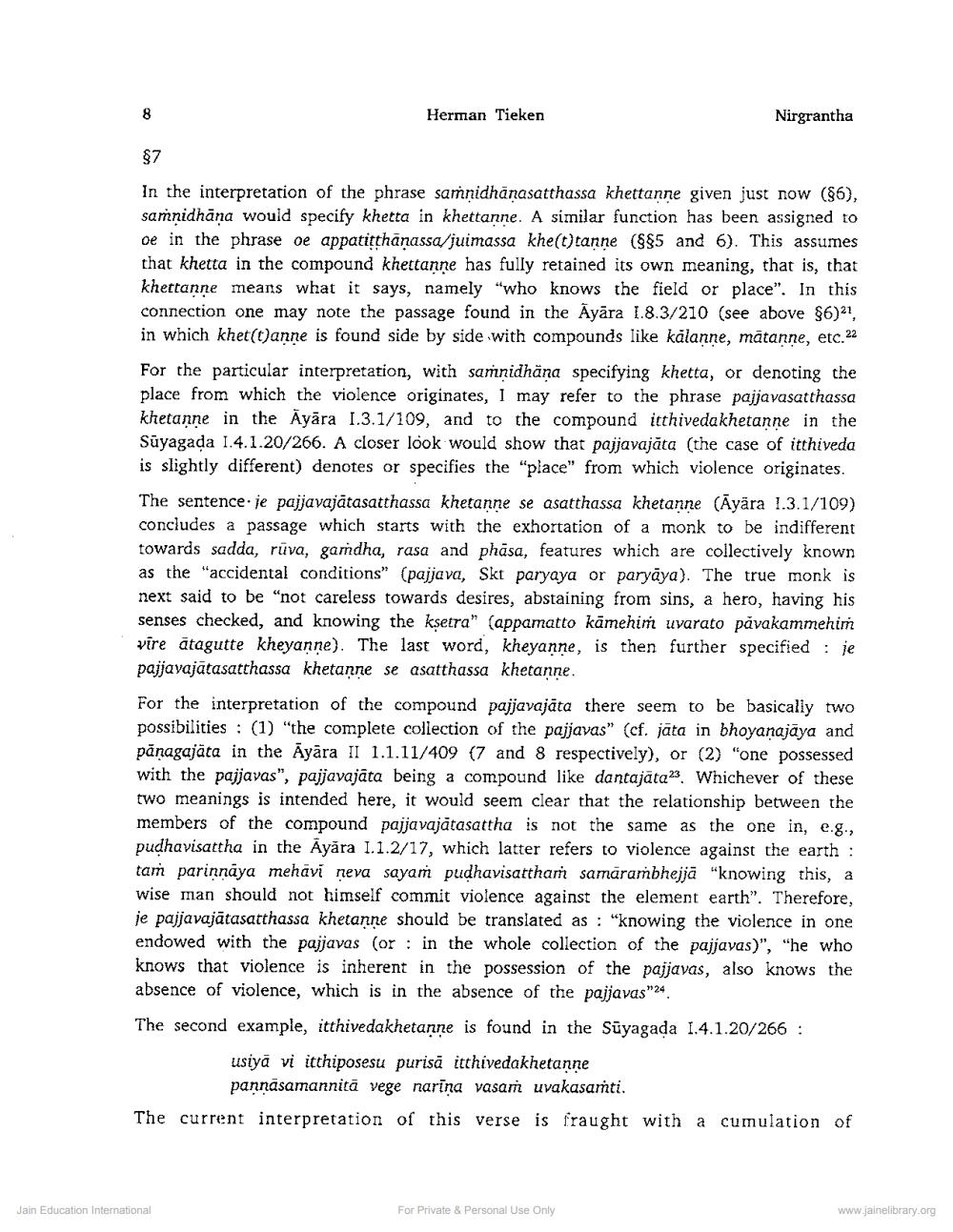Book Title: Word OE in Some Canonical Jaina Texts Author(s): Hermen Tieken Publisher: Z_Nirgrantha_1_022701.pdf and Nirgrantha_2_022702.pdf and Nirgrantha_3_022703.pdf View full book textPage 6
________________ Herman Tieken Nirgrantha In the interpretation of the phrase samnidhānasatthassa khettanne given just now (86), samnidhāna would specify khetta in khettanne. A similar function has been assigned to oe in the phrase oe appatitthanassa/juimassa khe(t)tanne ($95 and 6). This assumes that khetta in the compound khettanne has fully retained its own meaning, that is, that khettanne means what it says, namely "who knows the field or place". In this connection one may note the passage found in the Ayāra 1.8.3/210 (see above $62, in which khet(t)anne is found side by side with compounds like kalanne, mātanne, etc.22 For the particular interpretation, with samnidhāna specifying khetta, or denoting the place from which the violence originates, I may refer to the phrase pajjavasatthassa khetanne in the Āyāra 1.3.1/109, and to the compound itthivedakhetanne in the Sūyagada 1.4.1.20/266. A closer look would show that pajjavajāta (the case of itthiveda is slightly different) denotes or specifies the "place" from which violence originates. The sentence. je pajjavajātasatthassa khetanne se asatthassa khetanne (Āyāra 1.3.1/109) concludes a passage which starts with the exhortation of a monk to be indifferent towards sadda, rüva, gamdha, rasa and phāsa, features which are collectively known as the "accidental conditions" (pajjava, Skt paryaya or paryāya). The true monk is next said to be "not careless towards desires, abstaining from sins, a hero, having his senses checked, and knowing the kşetra" (appamatto kämenim uvarato păvakammehim vire ātagutte kheyanne). The last word, kheyanne, is then further specified : je pajjavajātasatthassa khetanne se asatthassa khetanne. For the interpretation of the compound pajjavajāta there seem to be basically two possibilities : (1) "the complete collection of the pajjavas" (cf. jāta in bhoyanajāya and panagajäta in the Āyara II 1.1.11/409 (7 and 8 respectively), or (2) "one possessed with the pajjavas", pajjavajāta being a compound like dantajäta. Whichever of these two meanings is intended here, it would seem clear that the relationship between the members of the compound pajjavajātasattha is not the same as the one in, e.g., pudhavisattha in the Ayıra 1.1.2/17, which latter refers to violence against the earth : tam parinnāya mehāvi neva sayam pudhavisattham samarambhejjā “knowing this, a wise man should not himself commit violence against the element earth". Therefore, je pajjavajātasatthassa khetanne should be translated as : "knowing the violence in one endowed with the pajjavas (or : in the whole collection of the pajjavas)", "he who knows that violence is inherent in the possession of the pajjavas, also knows the absence of violence, which is in the absence of the pajjavas"24. The second example, itthivedakhetanne is found in the Süyagada 1.4.1.20/266 : tsiya vị itthiposesu purisa itthivedakhetanne pannasamannitā vege narina vasam uvakasamti. The current interpretation of this verse is fraught with a cumulation of Jain Education International For Private & Personal Use Only www.jainelibrary.orgPage Navigation
1 ... 4 5 6 7 8 9 10 11 12 13 14 15 16
